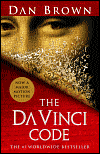 A confession: I'm obsessed with Dan Brown's The Da Vinci Code. I haven't read it, to tell you the truth, or at least much of it (I bought the book for my sister and browsed the first few pages), but my work on book history and intellectual property has led me to develop what's fast becoming a compulsive interest in it. Mostly, I'm riveted by the recent court case in Britain, in which the authors of The Holy Blood and the Holy Grail accused Brown of stealing key ideas and the "architecture" of their book. I won't burden you with the details, but a few weeks ago Justice Peter Smith found in Brown's favor.
A confession: I'm obsessed with Dan Brown's The Da Vinci Code. I haven't read it, to tell you the truth, or at least much of it (I bought the book for my sister and browsed the first few pages), but my work on book history and intellectual property has led me to develop what's fast becoming a compulsive interest in it. Mostly, I'm riveted by the recent court case in Britain, in which the authors of The Holy Blood and the Holy Grail accused Brown of stealing key ideas and the "architecture" of their book. I won't burden you with the details, but a few weeks ago Justice Peter Smith found in Brown's favor. Inasmuch as I'm excited by intellectual property law and jurisprudence, on their own they're usually not enough to get me this worked up. What's got me excited is the text of the judge's ruling, which evidently contains its own hidden code--"The Smithy Code." You can read about it by clicking this link to an article that ran recently in The New York Times.
You'll have to read The Da Vinci Code and The Holy Blood and the Holy Grail to crack The Smithy Code, and since I'm already behind in that department, I'm going to leave it to others to do so. For now, kudos to Justice Smith not only for handing down an intriguing decision, but more importantly, for embodying some of the principles and affects at stake in the case in the text of his ruling. I would, to be honest, like to see more scholarship--and jurisprudence, for that matter--adopt that kind of creative disposition. I've been trying to do this recently in my own work, specifically in my chapter-in-progress on Harry Potter counterfeits and knockoffs, for I find that letting the form of one's writing reflect that of its content can provide for a more engaging kind of academic discourse.
P.S. Read boldly.
4 comments:
h i d d e n m e s s a g e
Aha! At last--someone's cracked my pathetic attempt at a code!
Now for the next piece of the puzzle: to what comic book is my "hidden message" an homage?
_Groo the Wanderer_, perhaps?
Yes! Exactly--Groo the Wanderer it was. Well done.
Post a Comment